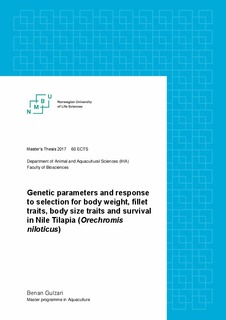| dc.description.abstract | This study evaluates the genetic parameters and selection responses in relation to harvest body weight, fillet yield, fillet weight, body size traits (length, depth, thickness) and survival of GenoMar Supreme Tilapia (GST™) strain (Oreochromis niloticus), which is currently at the 25th generation and the main continuation of the Genetic Improvement of Farmed Tilapias (GIFT) program. The breeding scheme implemented by GenoMar relies on DNA-marker-based tagging of the fish, and does not require the families to be grown separately until they reach a certain size. In this breeding scheme, all breeding candidates are reared in a common pond and eventually nearly 4% of them are pre-selected based on growth. Fillet yield (fillet weight*100/body weight) records and survival information are obtained from the full sibs of the breeding candidates, which are reared in a separate pond. The animals are selected for improved growth, fillet yield and survival. The body size traits (length, depth, thickness) are also measured, but not selected for.
In this study, pedigree starting from the base generation of GIFT (3rd generation) and phenotypes starting from the 12th generation were used. The overall heritabilities (h2) of the body weight, fillet yield, and survival were 0.179 ± 0.024, 0.215 ± 0.023, and 0.183 ± 0.024 respectively. Full-sib effect explained nearly 10% and 6% of the variation in body weight and fillet yield, respectively. The genetic correlation between body weight and fillet weight was large (0.861±0.002), suggesting that increased body weight may lead to increased fillet weight. Likewise, the genetic correlations between body weight and body size traits were high and positive. Fillet yield was genetically correlated with body weight positively and in a moderate magnitude (0.395±0.003), which indicates that increased body weight may result in improved fillet yield of the fish. Survival was positively correlated with all other traits. The overall selection responses for body weight (from 14th generation), fillet yield (from 17th generation), and survival (from 21st generation) were 0.19, 0.16, and 0.07 genetic standard deviations, respectively. The results suggest that the breeding program was responsive to selection and there is room for improvement in the future generations. | nb_NO |

